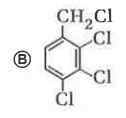An aromatic compound C7H6Cl2(A) , gives AgCl on boiling with alcoholic AgNO2 solution and yields C7H7OCl on treatment with sodium hydroxide. A on oxidation gives monochlorobezoic acid. The compound A is-Solution in Bengali




The correct Answer is:A
Topper's Solved these Questions
- HALOAKANES AND HALOARENESBOOK - CHHAYA PUBLICATIONCHAPTER - HALOAKANES AND HALOARENESEXERCISE - Solved NCERT Examplar Problems: Multiple Choice Questions(Single correct type)
30 Videos
- HALOAKANES AND HALOARENESBOOK - CHHAYA PUBLICATIONCHAPTER - HALOAKANES AND HALOARENESEXERCISE - Solved NCERT Examplar Problems: Multiple Choice Questions(More than One correct type)
11 Videos
- HALOAKANES AND HALOARENESBOOK - CHHAYA PUBLICATIONCHAPTER - HALOAKANES AND HALOARENESEXERCISE - Entrance Question bank: NEET
15 Videos
- GENERAL PRINCIPLES AND PROCESSES OF ISOLATION OF ELEMENTSBOOK - CHHAYA PUBLICATIONCHAPTER - GENERAL PRINCIPLES AND PROCESSES OF ISOLATION OF ELEMENTSEXERCISE - PRACTICE SET 6
10 Videos
- HYDROCARBONSBOOK - CHHAYA PUBLICATIONCHAPTER - HYDROCARBONSEXERCISE - PRACTICE SET 13
16 Videos
Similar Questions
The order of reactivity of following alcohols with halogen acids is-
(i) CH3CH2CH2OH (ii) CH3CH2CH(CH3)OH
(iii) CH3CH2C(CH3)2OH.
View SolutionConsider the following reaction and answer the question.

Which of the following statements are correct about this reaction-
View SolutionConsider the reactions:
(i) (CH3)2CH−CH2BrC2H5OH−−−−→(CH3)2CH−CH2OC2H5+HBr
(ii) (CH3)2CH−CH2BrC2H5O−−−−−−→(CH3)2CH−CH2OC2H5+Br−.
Mechanism of reactions (i) and (ii) are respectively-
View SolutionOut of C and CO which one is a better reducing agent at 673 K and why ?
View SolutionPh−C≡C−CH3Hg2+−−−→H3O+A .Here A is -
View SolutionAn organic compound (A) (C_(5)H_(7)OCl) reacts rapidly with ethanol to give (B) (C_(7)H_(12)O_(2)) . (A) also reacts with water to produce an acid which reacts with bromine to give (C ) (C_(5)H_(8)Br_(2)O_(2)) . (B) on boiling with H_(2)SO_(4) forms an acid (D). When (D) is oxidised with KMnO_(4) an acid (E ) (C_(4)H_(6)O_(3)) is produced. On mild heating, (E ) gives (F) (C_(3)H_(6)O) which cannot be oxidised by ammoniacal AgNO_(3) . Identify the compounds (A) to (F).
View SolutionAn aromatic compound (A), C_(7),H_(6)Cl_(2) gives AgCl on boiling with alcoholic AgNO_(3) soln. And yields C_(7)H_(7)Ocl on treatment with NaOH. (A) on oxidation gives a monochlorobenzoic acid which affords only the monoderivative on nitration the compound (A) is
View SolutionCompound A (C7H7Cl) react with aq. KOH at room temperature and give compound D(C7H8O). Another isomer B gives only one mononitration product on treatment with HNO3+H2SO4 mixture . Isomer C gives comound E(C7H5O2Cl) on heating with KMnO4 solution . E gives 3-chloro-4-nitrobezoic acid as major product . Identify compound D.
View SolutionAn aromatic compound 'A' (Molecular formula C_(8)H_(8)O) ) gives positive 2, 4-DNP test. It gives a yellow precipitate of compound 'B' on treatment with iodine and sodium hydroxide solution. Compound 'A' does not give Tollen's or Fehling's test. On drastic oxidation with potassium permanganate, it forms a carboxylic acid 'C' (Molecular formula C_(7)H_(6)O_(2) ), which is also formed along with the yellow compound in the above reaction. Identify A, B and C and write all the reactions involved.
View SolutionAn organic compound A (C_(7)H_(6)Cl_(2)) on treatment with NaOH solution gives another compound B (C_(7)H_(6)O) . B on oxidation gives and acid C (C_(7)H_(6)O_(2)) which on treatment with a mixture of conc. HNO_(3)" and "H_(2)SO_(4) gives a compound D (C_(7)H_(5)NO_(4)) . B on treatment with conc. NaOH gives a compound E (C_(7)H_(8)O)" and "C_(6)H_(5)COONa . Deduce the structures of [A], [B], [C], [D] and [E].
View SolutionAn aromatic compound C_(7)H_(7)Cl on oxidation gives another aromatic compound which on soda lime deccarboxylation produces benzene. The original compound is
View SolutionAn organic compound (A) C7H15CI on treatment with alcoholic caustic potash gives a hydrocarbon (B)C7H14(B) on treatment with ozone and subsequent hydrolysis gives acetone and butyraldehyde. What are (A) and (B)?
View SolutionAn aromatic compound C7H6CI2 (A), gives AgCI on boiling with alcoholic AgNO2 solution and yields C7H7OCI on treatment with sodium hydroxide (A) on oxidation gives monochlorobenzeoic acid. The compound (A) is
View SolutionAn aromatic compound 'A' (molecular formula C_(8)H_(8)O ) gives positive 2, 4-DNP test . It gives a yellow precipitate of compound 'B' on treatment with iodine and sodium hydroxide solution. Compound 'A' does not give tollen's or fehling's test. On drastic oxidation with potessium permanganate it forms a carboxylic acid 'C' (Molecular formula C_(7)H_(6)O_(2) ), which is also formed along with the yellow compound in the above reaction. identify A,B and C and write all the reactions involved.
View SolutionCompound (A) of molecular formula C7H8 when treated with air in presence of V2O5 at 773 K gives a compound (B) of molecular formula C7H6O, which has the smell of bitter almonds. Alkaline KMnO4 oxidises compound (B) to ( C) of molecular formula C7H6O2. Compound (B) on treatment with N2H4 and KOH gives back compound (A). Identify (A), (B) & ( C) and explain the reactions.
View Solution

